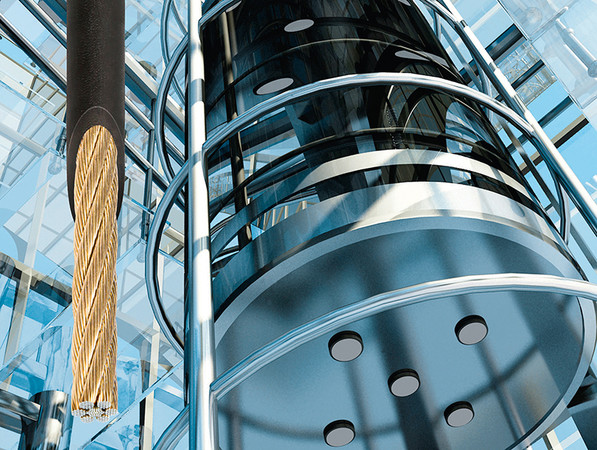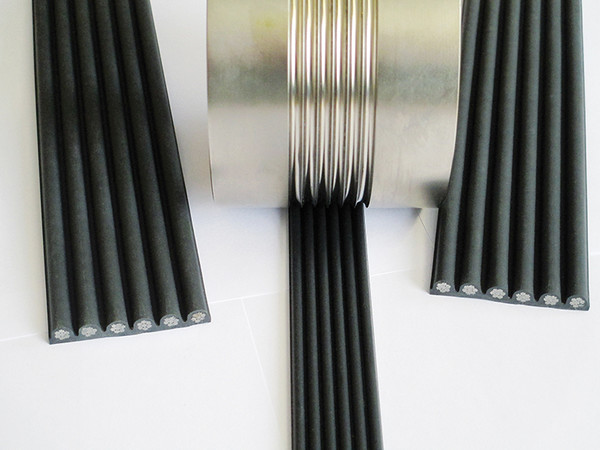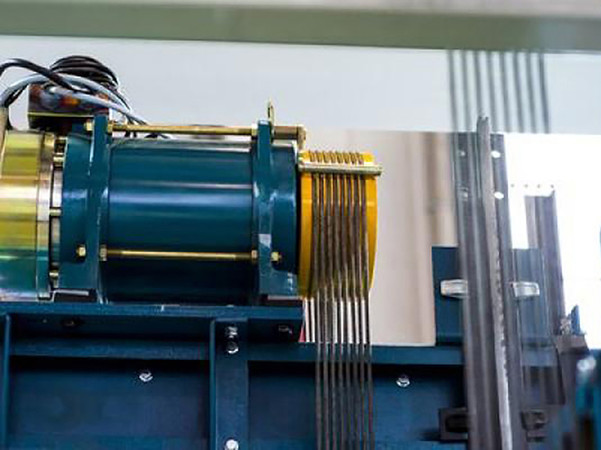Lifting gear for traction sheave lifts
The range of lifting gear for different lift designs has increased. In the final analysis, the selection of lift gear is a philosophical question.
However, knowing, comparing and evaluating the expectations, options, advantages and disadvantages should be prime considerations.
Higher, faster, further or like the trend in lift building: smaller, thinner, lighter? There is no universal solution, particularly for crucial mechanical elements like lifting gear. Instead, the individual systems with different conveyance heights and speeds, different optimisation approaches for maintenance and care, travel comfort and costs promote tailor-made solutions. However, the solution and goal must always be the system. The expectation that components – even crucial ones – like the lifting gear can be the sole solution is mistaken.
Rising cost pressure and sharp competition often prompt technical solutions that are then characterised purely by the cost optimisation parameter. However, in all discussions of reducing the costs – particularly when it comes to lifts that are safety-relevant and in public use – the requirements for safety and reliability should not be forgotten.
High buildings are only possible thanks to lifts where steel wire ropes are used as lifting gear. Moreover, in high buildings, the translationally moved mass of the steel wire rope with the limited friction coefficients to the traction sheave are considered to be the limiting factor.
Alternative: flat polyurethane belts?
 Photo: © Brugg Lifting
Photo: © Brugg LiftingInitially, in the 1990s, high tensile fibre ropes, in part with sheathing and coatings to enhance the coefficient of friction were deployed, which for various reasons did not become established. An important factor was that the lift was not constructed around the lifting gear, but rather the lifting gear was merely conceived of as a substitute for the tried-and-tested steel wire rope.
Flat polyurethane belts were an alternative development, which were fitted with tension members made of steel ropes or slightly offset high tensile fibres or also carbon fibre. The flat belts with tension members made of high tensile fibres were intended to make passenger conveyance technology independent of the conveyance height. A goal also pursued by ropeless vertical transport systems, which are not the topic here.
And the service life?
For small and medium conveyance heights, flat or longitudinally profiled belts with steel tension members with diameters d less than 2mm are in use, which are operated via drive and deflection pulleys with diameter D also under 100mm. The disc diameter is small. However, due to the small tension member diameter, the diameter relationships deflection to tension members is still above the "normative" limit at D/d=40.
As a result, the flexural strengths co-determinative of the service life are kept favourably low. In the case of suspension straps, the replacement state of wear is determined by the trip numbers, partially through changes in electrical resistance of the tension members, lifting gear damage or the usable life irrespective of use, etc.
Freedom in lift design
 Photo: © Contitec
Photo: © ContitecThe limiting parameter pair diameter relationship D/d≥40 and rope safety factor Sf≥12 against the minimum yield point still dates from the era of TRA200 – without taking the rope run and circumstances on the traction sheave into account. In EN 81-50, 5.12, previously EN 81-1, Annex N, combinations (Sf;D/d) are determined, taking the lift parameters into account, where Z=3·105 return trips are used as a basis.
As a result, the designer has much greater freedom in lift design. This approach is acceptable in safety terms, since the replacement state of wear can be detected between two examinations of the authorised inspection bodies. Whether this makes economic sense is something the hopefully well-advised operators can decide together with the lift manufacturer.
However, in various cases, the normatively assumed trip numbers are also still too high, e.g. for lifts that are not very busy. Consequently, rope manufacturers have had selected rope designs certified by notified bodies for small rope diameters d=6.0 and 6.5mm in order to make diameter relationships D/d≥18.6 also freely selectable for safety factors Sf≥12 depending on the rope operation parameters. However, the expectations should be compared with what is possible.
Detecting the replacement state of wear
What is not new, by contrast, is detection of the replacement state of wear by externally visible wire breaks under ISO 4344 or diameter reductions or rope damage according to DIN 15020, even if it has been withdrawn. Classic rope technology with rope diameters d=4mm has been certified in the effort to reduce the disc diameter. However – not least due to the elaborate installation of up to twelve ropes in 2:1 suspension – it is only to be found in niches.
More widely distributed, by contrast, are plastic-sheathed steel wire ropes with an external diameter of d=6mm, d=6.5mm and also in special cases d=8.1 mm from a few manufacturers. The rope sheathed with plastic with an external diameter d=6.5mm (dSteelrope=4.9mm) is authorised for disc diameters D≥115mm.
Restrictions due to replacement criteria
 Photo: © Gutachten Vogel
Photo: © Gutachten VogelThe trip numbers to be expected are stated depending on the use, i.e. number of bending cycles per trip. Due to greater flexural stresses, the trip numbers to be expected of the plastic-sheathed steel wire ropes are lower compared to belts with more favourable D/d relationships in the tension members. With regard to detecting the replacement state of wear, the trip numbers to be expected are stated according to the bend sequence for all plastic-sheathed rope products.
Depending on the configuration of the connection of the steel wire rope to the surrounding plastic sheath, detection of the replacement state of wear can be determined for reference lengths. Wire breaks through the plastic sheath or cracks in the sheath itself can be referred to as criteria. The fact that the use of plastic-sheathed steel ropes is to a large extent free from use restrictions by the component manufacturers is an advantage.
By Prof. Dr.-Ing. Wolfram Vogel
The author is a publicly appointed and sworn expert for lift rope and hoisting technology (expert office "Gut Achten").
More information: gutachten-vogel.de

























Write a comment